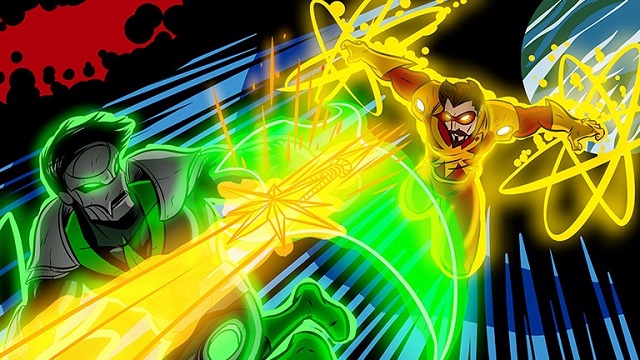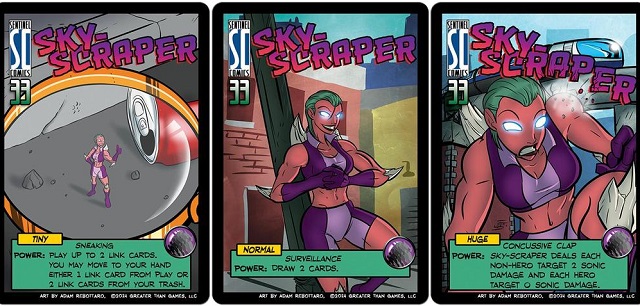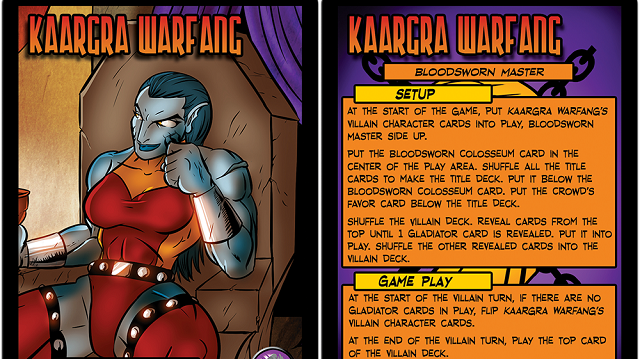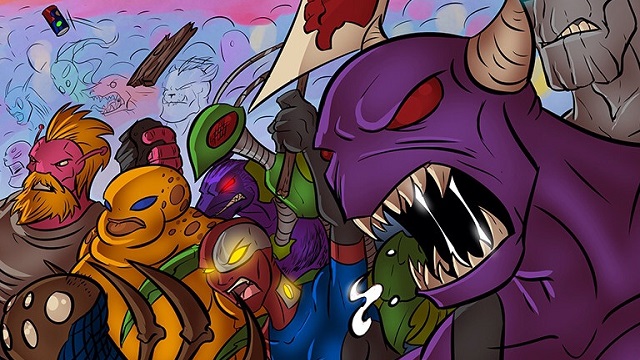
The ever-expanding multiverse of Greater Than Games’s “Sentinels Comics” takes an interstellar road trip with the latest supplement, Wrath of the Cosmos. As with previous expansions, Wrath contains two new heroes, two new environments, and four new villains for your cooperative comic-book enjoyment. Also like previous expansions, this one focuses on one particular aspect and related tropes of traditional comic superhero storytelling; in this case, that means extra-terrestrial threats to Earth and its surroundings!
Sentinels has touched on this briefly with the base set villain Grand Warlord Voss, and in fact at least two of the decks contained in Wrath have ties to Voss in the background story. The first is the environment Dak’Thorath Capital, which is set on the Thorathian homeworld and puts the heroes’ fight literally in the crossfire of the civil unrest between Voss’ regime and civilian freedom fighters.
One of these freedom fighters is Sky-Scraper, a Thorathian with the power to change her size at will. She actually has three character cards, each representing a different size. She can shift between these sizes by playing cards that allow her to do so. Her tiny size is great for infiltration and setting up traps, like her various Link cards, while her colossal size is handy for laying some giant smackdown on her enemies. Her normal size has its uses too, and in order to make the most of of her you will usually be shifting between her sizes constantly.

Sky-Scraper’s shifting between three distinct forms is reminiscent of Vengeance hero The Naturalist, who gets a proper nemesis in Wrath with the well-meaning if misguided Deadline. Deadline, as the last of his race, is seeking to prevent a cosmic extinction event from wiping out all life on Earth. Unfortunately, he has decided that the best way to achieve this is by inflicting so much damage on the planet and its inhabitants that the forces looking to destroy it will pass it over! If the environment deck ever has all of its cards removed by Deadline, the players instantly lose!
Deadline isn’t the only last survivor of their race kicking around Wrath, either. The other environment deck, Enclave of the Endlings, is full of them and the Collector-style being who shepherds them, Jansa Vi Dero (aka “the Terminarch”). This deck is a really interesting mix of forces, some helpful and others decidedly not. You never know what unique creature will show up each round, making every fight in the Enclave even more unpredictable than usual.
Equally unpredictable are fights against Sky-Scraper’s nemesis, Kaargra Warfang. Warfang is the owner and operator of the Bloodsworn Colosseum, a roving gladiatorial arena, and games with her as the villain are more about winning the favor of the bloodthirsty crowd than they are about defeating her. Her deck is actually two smaller decks. The first is mostly traditional, consisting of Gladiator minions and one-shots. The other is filled with titles that can be earned by meeting their respective criteria as they come up, granting their holder additional abilities.

But most importantly, both heroes and villains are competing for the crowd’s favor. Big hits, spectacular displays, earning titles and (of course) defeating your opponents are all ways to achieve this, and the first side to reach 20 favor wins the game! But beware: if there are ever no Gladiators in play at the start of the Villain Turn, Warfang herself steps into the arena and must be dealt with, as the heroes cannot win as long as she is active, no matter how much favor they have!
The other new hero in Wrath is Captain Cosmic, who can manipulate energy constructs in a manner very similar to DC’s various Lantern Corps. In an amusing reversal from their DC inspirations, the Captain’s constructs are yellow and the manifestations of insanity created by his nemesis Infinitor are green. Both Cosmic’s constructs and Infinitor’s manifestations are somewhat fragile (4 HP each), but Infinitor’s strength (and madness) bestow his with additional resilience… until he can no longer bear the tormenting voices any more and starts smashing them himself, not that this really helps the heroes any. For his part, Captain Cosmic is very much a team player, and usually bestows his constructs to other heroes to grant them additional abilities.
Finally, there is the “big boss” of Wrath, Progeny. This avatar of destruction is easily on par with heavy hitters like Iron Legacy and will be a true challenge to any who stand in its way. Its abilities shift constantly as it is capable of taking on various forms nearly at will. Worse yet, these forms (“scions”) are almost impossible for the heroes to destroy since they lack any of the traditional keywords, so you just have to bear the brunt of the storm and get your hits in when and where you can. Ominously, it is hinted that Progeny is only the precursor for an even greater force. Kind of like a herald of Galactus, if you’re up on your Marvel lore. What that force is remains to be seen, but you can be sure that the Sentinels of the Multiverse will be there to face it if and when it arrives.

As you can probably tell, Wrath of the Cosmos is another great addition to the tried and true Sentinels of the Multiverse experience. If you want to further expand your game, be on the lookout for mini-expansions that are available individually alongside Wrath. These include the hero Guise (think Deadpool, but with far fewer guns), villain Wager Master (not wholly unlike DC’s impish Mister Mxyzptlk), and the environment deck Omnitron-IV. Yes, that’s right: it is now possible to have Omnitron-X (the hero) fighting Omnitron (the villain) inside Omnitron-IV (the environment)!
Omni-ception aside, each new deck increases the potential combinations in Sentinels to new heights. The possibilities are nearly limitless and growing all the time. No two games of Sentinels are ever the same, and this variety keeps my friends and I coming back to the Multiverse again and again.
Wrath of the Cosmos retails for $20. Each individual mini-expansion retails for $5.



















